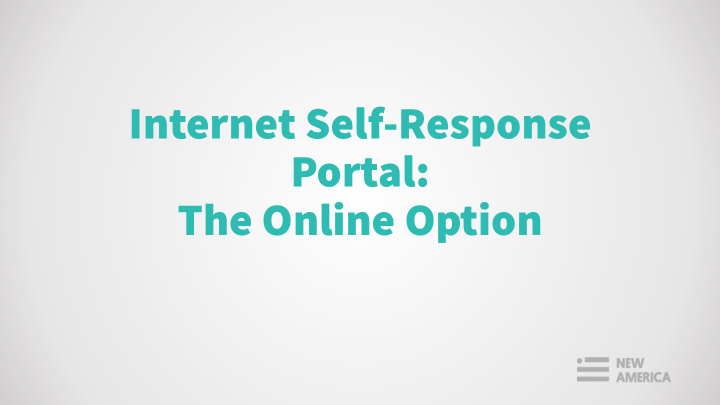



Internet Self-Response Portal: The Online Option
This Overview Includes: • Key things to know about the Internet Self-Response Portal (ISR), commonly referred to as the “online option” • A draft letter that housing units will start to receive in mid-March 2020 • Type of Enumeration (TEA) maps that show which kind of mailing census tracts will receive • A screenshot review of the experience • Guidelines for setting up a census kiosk 2
Key Things to Know: • Housing units will receive a letter w 12-digit code. Ideally, this code is entered into the ISR to begin filling out the form. If someone does not have a code, it is possible to start the form without it. • The form must be completed the form in one sitting. If there is no activity for 13 minutes, a reminder will pop up to complete the form. If there is no activity for 15 minutes, the session will end and the respondent will have to start from the beginning. • Resources for organizations setting up census kiosks are available at the end of this document. 3
What to Expect: Housing Units Receive a Letter 4
Note the mention that paper forms will be mailed a few weeks after the initial letter, as well as a phone number to call for assistance. 5
Where to Expect It: Type of Enumeration Area (TEA) source: censushardtocountmaps2020.us see also: census.gov/roam; 2020census.gov 6
The Internet Self Response Portal (ISR) (Live demo available - census.gov/about/cac/nac/meetings/2019-11-meeting.html session is day 2, at 1 hour and 54 minutes) 7
The Landing Page 8
(12 non-English languages available) 9
The ID Response: Enter 12 Digit ID and Login 10
Verify Your Address 11
Confirm Address on April 1, 2020 12
Enter Name and Phone Number (phone number is optional) 13
Have a Question? Use the FAQs! 14
Begin with Household Questions 15
Enter the Names of Everyone in the Household 16
A Reminder to Include Everyone! 17
Select Type of Housing Unit 18
Select Home Owner (if applicable) 19
Next is Questions about People 20
Select Sex 21
Enter Date of Birth (age is automatically calculated but can be manually changed) 22
Select Hispanic Origin 23
Select Race Here’s all the options! 24
Optional: Include Origin Details (text boxes will expand to include more information) 25
Make Edits or Start with the Next Person 26
Select Relationship to Person 1 Here’s all the options! 27
Questions About Person 2 28
When All People Are Entered, Go to Final Questions 29
Ensuring Everyone is Counted Only Once 30
Last Chance to Make Changes 31
A Confirmation that Form is Submitted 32
Don’t Have and ID? No Worries! The Start of the Form is Slightly Different... 33
Select “...do not have a Census ID… ” 34
Select Where You Will Live on April 1, 2020 35
Enter a Street Address if Applicable 36
Select Rural Address 37
Select Homelessness 38
Enter as Much Detail as Possible 39
Guidelines for Setting up a Census Kiosk Censuscounts.org • − GOTC toolkit, censuscounts.org/gotc-toolkit-cybersecurity/ − Tech FAQs, censuscounts.org/resources/census-2020-technology-faqs/ Other resources • − American Library Association, ala.org/news/press-releases/2019/05/ala-releases-new-libraries-gui de-2020-census − Digital Equity Lab, digitalequitylab.org − Code for America is helping to build digital capacity for the count. Find out if they’re in your city, brigade.codeforamerica.org contact: filippelli@newamerica.org 40
Recommend
More recommend